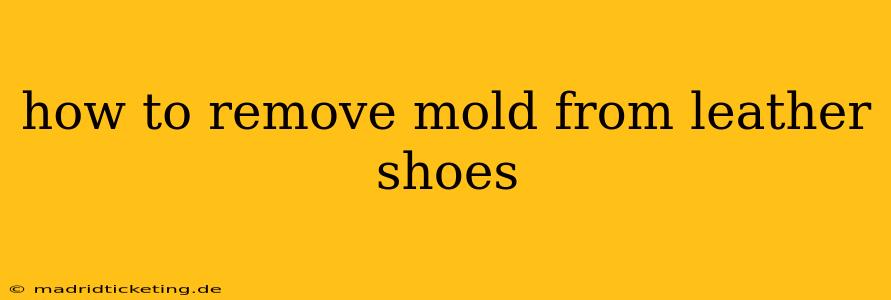Mold on your beloved leather shoes? Don't despair! While it's unsightly and potentially harmful, with the right approach, you can often restore your footwear to its former glory. This guide offers a step-by-step process, addressing common concerns and providing expert tips for effective mold removal. Remember, prevention is key, so we’ll also cover storage and care tips to keep mold at bay.
What Causes Mold on Leather Shoes?
Mold thrives in damp, dark environments. Leather shoes, particularly if stored improperly or exposed to moisture, provide the perfect breeding ground. Sweat, rain, spills, and even high humidity can create the conditions necessary for mold growth. Identifying the source of the moisture is crucial for preventing future occurrences.
How Do I Clean Mold From Leather Shoes?
The best approach depends on the severity of the mold infestation. For minor mold spots, a gentle cleaning might suffice. For more extensive mold growth, more aggressive methods may be necessary. Always test any cleaning solution on an inconspicuous area first to ensure it doesn't damage the leather.
For Mild Mold:
- Preparation: Brush off any loose mold spores with a soft-bristled brush. This prevents spreading the mold during cleaning.
- Cleaning Solution: Mix a solution of mild dish soap and lukewarm water. A gentle leather cleaner is also a good option.
- Application: Dip a soft cloth or sponge into the solution and gently wipe the affected areas. Avoid soaking the leather.
- Drying: Allow the shoes to air dry completely in a well-ventilated area away from direct sunlight or heat. Stuffing the shoes with clean paper towels can help absorb moisture.
For Moderate to Severe Mold:
- Preparation: As above, brush off loose spores. For severe cases, consider wearing gloves and a mask to protect yourself from mold spores.
- Cleaning Solution: For tougher mold, you can try a solution of white vinegar and water (equal parts). Again, test on an inconspicuous area first. Isopropyl alcohol (70% solution) can also be effective, but use it sparingly as it can dry out the leather.
- Application: Apply the solution with a soft cloth or cotton swab, gently scrubbing the affected areas.
- Drying: Air dry completely as described above.
After Cleaning:
Once the shoes are completely dry, apply a leather conditioner to restore moisture and protect the leather. This helps prevent future mold growth and keeps your shoes looking their best.
What if the Mold is on the Inside of My Leather Shoes?
Mold inside your shoes is even more concerning as it can affect your feet. If the mold is on the insole, replace it immediately. For mold on the inner lining, you'll need to be more thorough. Follow the steps above, paying close attention to reaching all areas. You may need to use a small brush or cotton swab to reach crevices. If the mold is extensive or you can't remove it effectively, it may be best to discard the shoes.
Can I Use Bleach on Leather Shoes with Mold?
No, absolutely not. Bleach is extremely harsh and will severely damage leather. It will ruin the material and potentially make the mold problem worse. Stick to the gentler cleaning solutions outlined above.
How Can I Prevent Mold in My Leather Shoes?
Prevention is far easier than cure! Here's how to keep mold away from your leather shoes:
- Proper Storage: Store shoes in a cool, dry, and well-ventilated area.
- Shoe Trees: Use shoe trees to help maintain the shape of the shoes and absorb moisture.
- Regular Cleaning: Regularly wipe down your shoes with a damp cloth after wearing them, particularly if they've been exposed to moisture.
- Air Drying: Always air dry your shoes thoroughly after getting them wet. Avoid using direct heat or sunlight.
By following these steps and taking preventative measures, you can keep your leather shoes mold-free and extend their lifespan. Remember, if the mold is extensive or you're unsure how to proceed, consult a professional shoe cleaner or leather restoration specialist.

